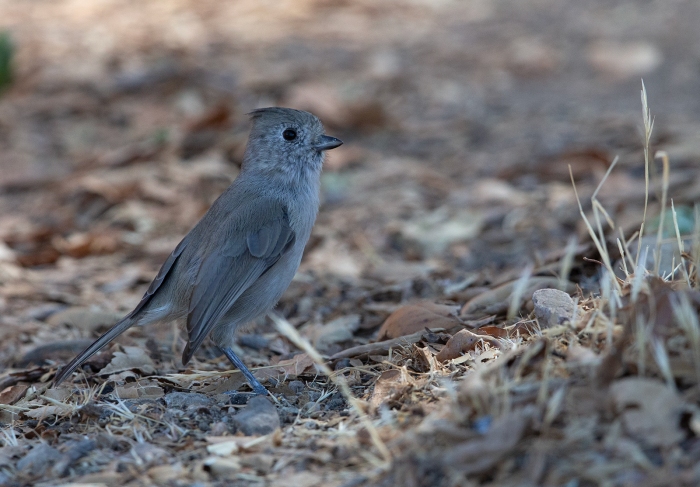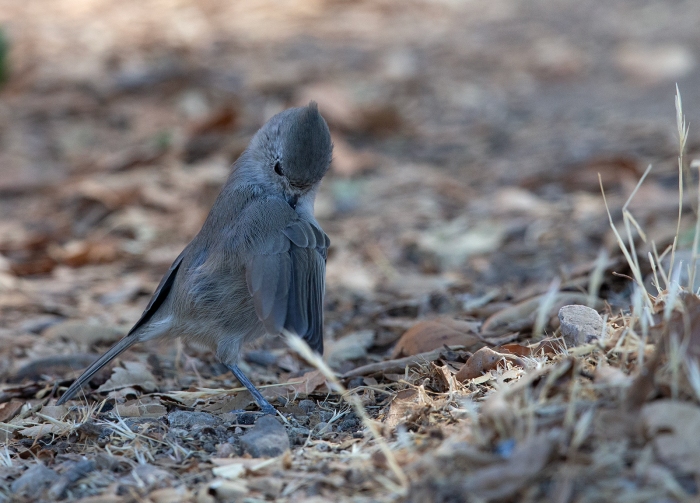
The Oak Titmouse is a California near-endemic, with a few birds breeding in southwesternmost Oregon and a few in northernmost part of Baja California. (There’s a small, isolated population of Oak Titmice on the southern tip of Baja California; it’s origin is uncertain.) Mostly, it’s found in the mixed oak forests of the foothills of the Sierra Nevada, where it is among the most common bird species in the oak woodlands. It’s a highly vocal species, singing and calling year-round.
Until 1997 it was called the Plain Titmouse, an apt name for a somewhat drab species. In 1997, the Plain Titmouse was split into the Oak Titmouse and the Juniper Titmouse. Sometimes a species split is controversial; in the case of the Plain Titmouse, the reaction in the birding community was more along the lines of “It’s about time.” Even so, there is considerable color variation, from dull brown to dull gray, among Oak Titmice across their range, and no less than four subspecies identified.

The pair bonds in Oak Titmice are formed almost immediately upon dispersal from the nest, and those pair bonds generally last the life of the birds. And Oak Titmice remain in the same territory continuously as well, defending it against other titmice. Unlike most members of the Paridae family, Oak Titmice rarely join mixed flocks and rarely leave their patch. Those territories are relatively small; it’s not unusual to stand in one place and hear 3 – 4 different Oak Titmice calling.
The female selects the nest cavity and constructs the nest inside the cavity. The cavity may be a woodpecker hole, a cranny in a bent oak branch or a nest box. Nests are commonly reused in successive years. There are 3 – 9 eggs, on average 7. The female is the sole incubator of the eggs, which hatch in 14 – 16 days. The male feeds the female while she is incubating. Both parents feed the nestlings. The nestlings fledge in 16 – 21 days, called from the nest cavity by the adults. The fledglings are fed by both parents, and begin independently foraging for themselves after about five days. By five weeks after fledging, the youngsters are feeding themselves in dependently.

Reproductive success is tied to habitat, but seems to average 78 – 91%. But only about one in four juvenile birds will survive to breed. Average life span is estimated at 3.5 years, but life span can be as long as eight years. Breeding Bird Surveys estimate a total population of about 580,000 individuals, dealing slowly by 1 – 1.5% per year.
Oak Titmice depend upon oak woodlands, and that habitat in California is under threat from various human activities, including clearing for agriculture, rangeland, and urbanization, as well as harvesting for fuelwood. While the oak woodlands favored by Oak Titmice are adapted to range fires, in recent years human-caused fires have been hotter and larger, effectively sterilizing the habitat. Threats are exacerbated by explosive human population growth. Since 1900, population of California has increased from approximately 1.5 million to 39 million people, resulting in declines of 25–50% in acreage of oak woodlands. Because over 80% of oak woodlands in California are privately owned, management programs also need to consider differences in ownership patterns. Efforts to conserve oak woodlands are only going to succeed if those management programs involve education and collaboration between resource managers and landowners.
Despite the threats, given the range of the species and the large number of individuals, the IUCN classifies the Oak Titmouse as a species of Least Concern.
For more bird photographs, please visit WC’s bird photo site, Frozen Feather Images.

